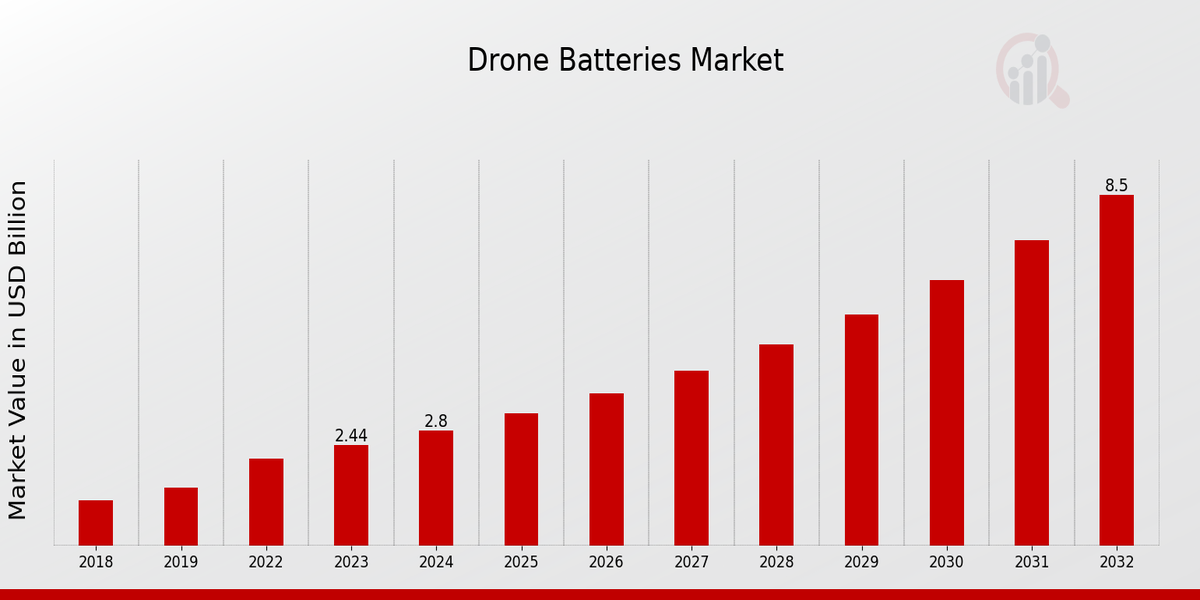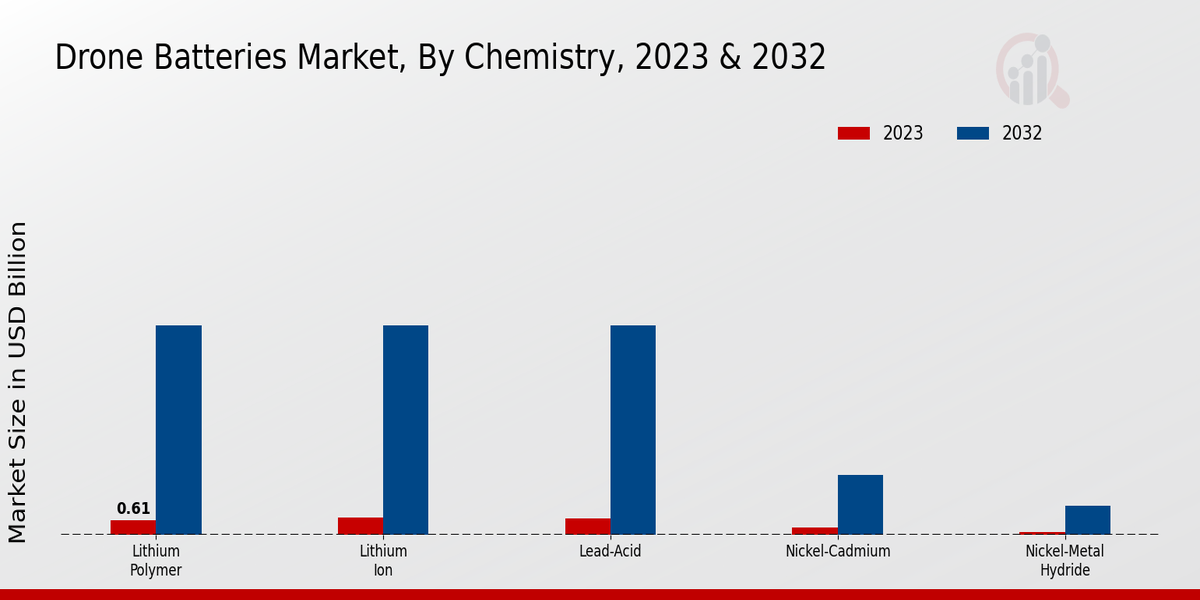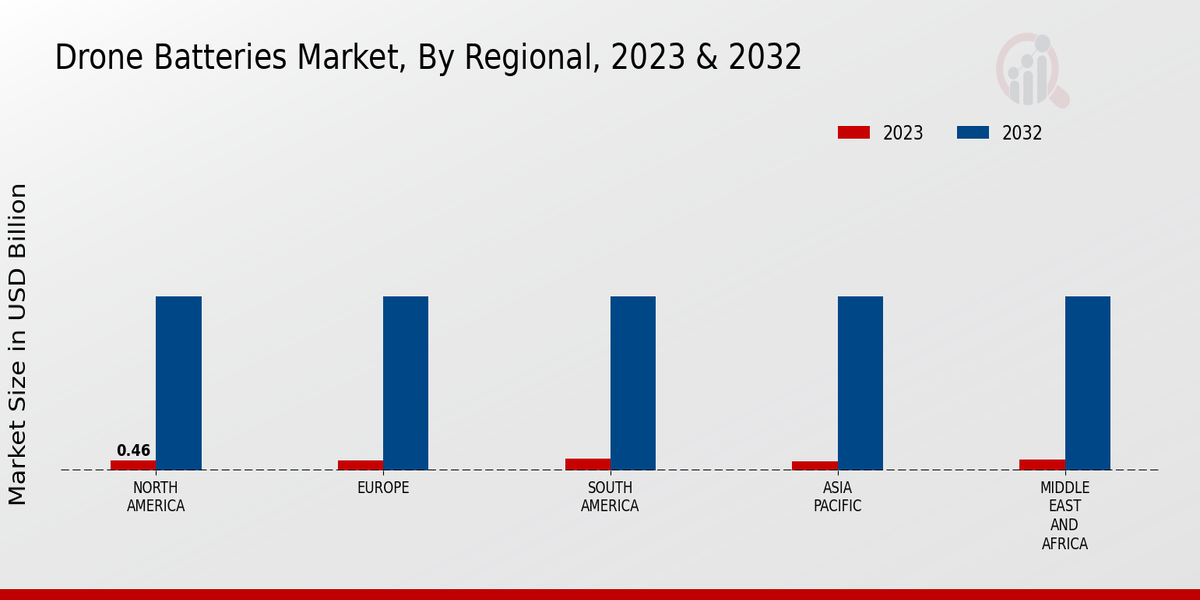Global Drone Batteries Market Overview
As per MRFR analysis, the Drone Batteries Market Size was estimated at 2.12 (USD Billion) in 2022.The Drone Batteries Market Industry is expected to grow from 2.44(USD Billion) in 2023 to 8.5 (USD Billion) by 2032. The Drone Batteries Market CAGR (growth rate) is expected to be around 14.88% during the forecast period (2024 - 2032).
Figure 1: Drone Batteries Market Size, 2023-2032 (USD Billion)

Source: Primary Research, Secondary Research, MRFR Database and Analyst Review
Key Drone Batteries Market Trends Highlighted
The growing adoption of drones in various commercial and recreational applications is driving the demand for drone batteries. Advancements in battery technology, such as the development of high-capacity, lightweight, and fast-charging batteries, are further fueling market growth. Furthermore, the increasing use of drones for aerial photography, cinematography, and surveillance is creating opportunities for the drone batteries market.
Environmental concerns are also influencing the market as the demand for sustainable and eco-friendly battery solutions grows. Governments and organizations are promoting the adoption of greener technologies, which is expected to drive the development of advanced and environmentally friendly drone batteries. Additionally, the ongoing development of autonomous drones and the integration of artificial intelligence (AI) are expected to further boost the demand for high-performance and long-lasting drone batteries.
Drone Batteries Market Drivers
-
Advancements in Drone Technology
The application of new technologies in aviation is one of the most promising and fast-growing trends in the Global Drone Batteries Market Industry. Modern drones are becoming more serious and sophisticated technologies, which opens up significant potential in front of developers and manufacturers of drones and their components. In particular, the technology and battery industry develop with the main market and creates new innovative concepts of batteries that push the development of the drone market, as well as the opportunities for using drones in different fields of life.For example, in 2023, MIT researchers introduced a new drone battery that 3 times more powerful than existing models.
In addition, the more advanced design of drones that are represented in the market in the updated industry has also opened up new capacities for using drones beyond aviation. Thus, fixed-wing drones cause an increased need for batteries with great power that will allow them to be in the air for a long time. On the contrary, vertical take-off and landing drones demand the development and production of batteries with a high-power supply but for a short time.The leadership of drones, as well as similar current fast-growing technologies, promises a significant increase in the number and capacity of batteries further on.
Growing Adoption of Drones in Commercial Applications
External – An instance of a major driver of the expansion of the Global Drone Batteries Market Industry is the growing adoption of drones for commercial purposes. There are a lot of purposes for which drones are used in the commercial sector, such as aerial photography and videography, delivery services, and infrastructure inspection. For example, a giant branch of Amazon is using drones to deliver its packages to customers in several cities. The rise of drones’ use for commercial purposes has created a high demand for drone batteries, which should be reliable and should be able to last long.
Thus, the batteries used in drones for delivery purposes should have the ability to last long, be relatively cheap, and have a high payload. Drone batteries used for infrastructure inspection should be high-powered in short bursts. As this commercial sector continues to develop, there is no doubt that the drone batteries market will increase in the future.
Increasing Government Support for Drone Technology
Government support for drone technology has been increasing over the years. As drones become more and more popular, governments around the world are realizing the potential for drones to improve public safety, security, and efficiency. As a result, governments are taking steps to support the growth of the drone industry. For example, the US government is investing in the development of new drone technologies for use by law enforcement and the military.
Additionally, governments are creating new regulations to ensure that drones are used safely and responsibly. For example, the US Federal Aviation Administration has created new regulations for the operation of drones in the US. The new regulations are designed to help ensure that drones are used safely and responsibly and will help pave the way for the growth of the drone industry.
Drone Batteries Market Segment Insights
Drone Batteries Market Chemistry Insights
The Global Drone Batteries Market is segmented by chemistry, such as Lithium Polymer, Lithium Ion, Lead-Acid, Nickel-Cadmium, Nickel-Metal Hydride, and Zinc-Air. Among the above-mentioned chemistries, Lithium Polymer is anticipated to be the most attractive segment, and it held the largest segment in the Global Drone Batteries Market in the year 2023 and is anticipated to exhibit a continuation of the same throughout the forecast period. LiPo batteries provide high energy density, are light in weight, and have long cycle life, so they are well suited for drones that need to be in the air for long periods of time and require more power.
The lithium-ion batteries segment is projected to grow with a significant CAGR throughout the forecast period, attributable to the increasing adoption of Li-ion batteries in commercial and industrial drones. The batteries have higher energy density than LiPo batteries and less thermal runaway, which makes them safer for drones. The Lead-Acid batteries are used in budget drones as they are low in cost and have a wider availability. The lower energy density and limited cycle life restrict its use in high-performance drones.
Nickel-cadmium and Nickel-Metal Hydride batteries are being phased out gradually as they have lesser energy density and cycle life and have now been replaced by dual Lithium Ion and Lithium Polymer batteries. Zinc Air batteries are an upcoming technology for drones as they have high energy density and are low in cost. However, it has a low cycle life, and moisture is a problem as it reacts with zinc. The growing adoption of drones for aerial photography, videography, surveillance, and delivery.
Figure 2: Drone Batteries Market, By Chemistry, 2023 & 2032

Source: Primary Research, Secondary Research, MRFR Database and Analyst Review
Drone Batteries Market Capacity Insights
The capacity segment is one of the most important factors in the global drone batteries market, and it influences market growth and revenue opportunities. The 1000mAh – 5000mAh capacity segment had the highest value of the market size in 2023 as the segment is the most versatile and compatible with a wide range of drone applications. This segment is expected to maintain this dominance during the forecast period, while the growth is set to be the slowest with a steady CAGR. Below 1000mAh capacity segment has a more niche application as it fits smaller drones, but the growth is expected to be moderate due to the quickly growing popularity of unmanned aerial vehicles.
The 5000mAh – 10000mAh capacity segment is also becoming more popular as it allows drones to fly for an extended period, primarily used in commercial and industrial drones. The 10000mAh – 15000mAh capacity segment is expected to grow at a relatively high rate as Long-range Drones are utilized in surveillance, mapping, and delivery by companies such as DHL. Above 15000mAh also grew at a moderate rate, although the market for heavy-lift drones is smaller than in other applications, such as construction and mining.
Drone Batteries Market Voltage Insights
The voltage segment plays a crucial role in the Global Drone Batteries Market segmentation. Different voltage batteries cater to specific drone applications and performance requirements. Among the mentioned voltage ranges, 11.1V batteries hold a significant market share due to their widespread use in smaller drones and hobbyist applications.
As we move up the voltage range, 14.8V and 22.2V batteries gain prominence in professional drones and aerial photography, offering higher power output and longer flight times. 29.6V and 36V batteries are primarily utilized in industrial and commercial drones, where extended flight duration and heavy payload capabilities are critical.
The Global Drone Batteries Market revenue for the voltage segment is projected to grow substantially in the coming years, driven by the increasing demand for high-performance drones across various industries. Market data suggests that the industry will continue to innovate and introduce new voltage options to meet the evolving needs of the drone market.
Drone Batteries Market Application Insights
The Application segment is a crucial aspect of the Global Drone Batteries Market segmentation, influencing market growth and industry dynamics. Commercial drones, which account for a significant portion of the market, are primarily utilized for commercial applications such as aerial photography, videography, inspection, mapping, and delivery services.
Consumer drones, on the other hand, are geared toward hobbyists and recreational users, offering features such as high-quality cameras and advanced flight capabilities. Military drones play a vital role in defense and security operations, providing surveillance, reconnaissance, and combat capabilities.
Industrial drones are employed in various industries, including construction, mining, and energy, for tasks such as inspection, monitoring, and data collection. Agricultural drones are gaining traction in the agricultural sector, offering precision spraying, crop monitoring, and livestock management capabilities.
The Global Drone Batteries Market revenue is expected to witness substantial growth in the coming years, driven by the increasing adoption of drones across various applications. Key market players are focusing on developing innovative battery technologies to meet the growing demand for longer flight times, higher power output, and improved safety features.
Drone Batteries Market Durability Insights
The Durability segment of the Global Drone Batteries Market is categorized into Standard, High, and Extended. The Standard segment held the largest market share in 2023, accounting for approximately 45% of the global revenue. This dominance is attributed to the cost-effectiveness and widespread availability of standard batteries.
However, the High and Extended segments are projected to experience significant growth in the coming years due to the increasing demand for drones with longer flight times and higher performance capabilities. The High segment is expected to grow at a CAGR of 16.5% during the forecast period, while the Extended segment is anticipated to grow at a CAGR of 18.2%.
This growth is driven by the increasing adoption of drones in commercial applications, such as aerial photography, videography, and delivery services.
Drone Batteries Market Regional Insights
The regional landscape of the Global Drone Batteries Market presents distinct growth trajectories across key regions. North America leads the market, capturing a significant share due to the presence of major drone manufacturers and a robust ecosystem for drone adoption. Europe follows closely, driven by growing demand for commercial drone applications in industries such as construction, inspection, and surveillance. Asia-Pacific (APAC) is a rapidly emerging market with a growing number of drone manufacturers and a surge in drone usage in agriculture, logistics, and e-commerce.
South America, the Middle East, and Africa (MEA) are witnessing increasing adoption of drones, particularly in sectors such as mining, oil and gas, and security. These regions are expected to contribute to the overall market growth in the coming years.
Figure 3: Drone Batteries Market, By Regional, 2023 & 2032

Source: Primary Research, Secondary Research, MRFR Database and Analyst Review
Drone Batteries Market Key Players And Competitive Insights:
Key participants in the drone batteries market are continually attempting to gain a competitive advantage. Leading gamers in the market are focusing on creation and technological developments to separate their product offerings from those of their competitors.
The advancement landscape of drone batteries is noted for businesses forming tactical collaborations, alliances, and the growing pattern of mergers and acquisitions to bolster their market position and expand the market share. The competition underneath the drone batteries market is projected to remain entrapped due to the inclusion of the entrance of new recruits and niche players. On the basis of appropriate positioning and substantial enhancements, key people are predicted to benefit considerably.
One of the most noteworthy members of the drone batteries market is DJI. The firm has vast exposure to the international drone industry. DJI offers a variety of drone batteries for its clientele, including multiple capacities and output types. The characteristics of DJI’s batteries vary in terms of amperage, Voltage, elevation, and favorable operational settings.
DJI strives to develop the most advanced general drone technologies, and Research is the company's primary goal, which is reflected in its high-quality goods and massive customer base. DJI’s advanced technology, broad range of products, and excellent branding put it at the top of the market, providing a substantial competitive advantage in the market of drone batteries.
One of the greatest drone battery suppliers is Parrot. The business has specialized in developing and handling drones and drone accessories in contrast to other rugged furniture makers. Parrot’s products appeal to a variety of customers, including customers, growing novices, and technology enthusiasts. In comparison to DJI, Parrot is well-regarded for its products and its facilities.
Furthermore, Parrot has a lot of customers in Europe, with a large portion of the market share being based there. Inspired by the willingness of drone fans to create new and exceptional items, Parrot has been a major investigator in the field. The brand’s solid image in the drone sector and the organization’s capacity to meet the needs of both professionals and amateurs put it in a robust competitive position.
Key Companies in the Drone Batteries Market Include
Drone Batteries Market Industry Developments
The global drone batteries market is projected to grow from USD 2.44 billion in 2023 to USD 8.5 billion by 2032, exhibiting a CAGR of 14.88% during the forecast period. The market growth is attributed to increasing demand for drones in various industries, including commercial, military, and consumer applications. Technological advancements, such as the development of higher-capacity and longer-lasting batteries, are also driving the market growth.
Furthermore, government initiatives to promote the use of drones for various applications are expected to provide impetus to market growth. Recent news developments include partnerships between drone manufacturers and battery suppliers to develop and supply advanced drone batteries. For instance, in January 2023, Autel Robotics, a leading drone manufacturer, partnered with Samsung SDI to develop and supply high-performance batteries for its drones.
Drone Batteries Market Segmentation Insights
-
Drone Batteries Market Chemistry Outlook
-
Drone Batteries Market Capacity Outlook
-
-
Below 1000mAh
-
1000mAh - 5000mAh
-
5000mAh - 10000mAh
-
10000mAh - 15000mAh
-
Above 15000mAh
-
Drone Batteries Market Voltage Outlook
-
11.1V
-
14.8V
-
22.2V
-
29.6V
-
36V
-
Drone Batteries Market Application Outlook
-
Commercial Drones
-
Consumer Drones
-
Military Drones
-
Industrial Drones
-
Agricultural Drones
-
Drone Batteries Market Durability Outlook
-
Drone Batteries Market Regional Outlook
-
North America
-
Europe
-
South America
-
Asia Pacific
-
Middle East and Africa
| Report Attribute/Metric |
Details |
| Market Size 2022 |
2.12 (USD Billion) |
| Market Size 2023 |
2.44 (USD Billion) |
| Market Size 2032 |
8.5 (USD Billion) |
| Compound Annual Growth Rate (CAGR) |
14.88% (2024 - 2032) |
| Report Coverage |
Revenue Forecast, Competitive Landscape, Growth Factors, and Trends |
| Base Year |
2023 |
| Market Forecast Period |
2024 - 2032 |
| Historical Data |
2019 - 2023 |
| Market Forecast Units |
USD Billion |
| Key Companies Profiled |
Grepow Batteries, Gens Ace Batteries, DJI Batteries, Eflite Batteries, Yuneec Batteries, Hyperion Batteries, Sky Lipo Batteries, Tattu Batteries, Pulse Batteries, Team BlackSheep Batteries, Walkera Batteries, Thunder Power Batteries, Parrot Batteries, Autel Robotics Batteries |
| Segments Covered |
Chemistry, Capacity, Voltage, Application, Durability, Regional |
| Key Market Opportunities |
Battery technology advancementsGrowing commercial drone adoptionIncreasing demand for drones in surveillance and mappingGovernment regulations for drone operationRising popularity of drone racing |
| Key Market Dynamics |
Rising Drone AdoptionAdvancements in Battery TechnologyIncreasing Focus on Safety and ReliabilityStringent Government RegulationsGrowing Demand from Commercial Applications |
| Countries Covered |
North America, Europe, APAC, South America, MEA |
Frequently Asked Questions (FAQ) :
The global drone batteries market is anticipated to reach a valuation of USD 8.5 billion by 2032, expanding at a CAGR of 14.88% from 2024 to 2032.
North America and Europe are anticipated to dominate the drone batteries market due to the high adoption of drones in these regions. Asia-Pacific is projected to witness significant growth owing to the increasing demand for drones in commercial and consumer applications.
Drone batteries are primarily utilized in powering drones for various applications, including aerial photography and videography, surveillance, delivery services, and military operations.
Prominent players in the drone batteries market include Grepow Batteries, Gens Ace Batteries, DJI Batteries, Eflite Batteries, Yuneec Batteries, Hyperion Batteries, Sky Lipo Batteries, Tattu Batteries, Pulse Batteries, Team BlackSheep Batteries, Walkera Batteries, Thunder Power Batteries, Parrot Batteries, Autel Robotics Batteries
The increasing popularity of drones for commercial and recreational purposes, technological advancements leading to improved battery performance, and the growing adoption of drones in industries such as agriculture and construction are key factors driving market growth.
Challenges include the need to improve battery life and power density, ensure safety and reliability in drone operations, and address regulatory concerns related to drone battery usage.
The future of the drone batteries market appears promising due to the rising demand for drones and the continuous advancements in battery technology. Innovations in battery design, materials, and charging methods are expected to further enhance battery performance and contribute to the growth of the market.
Trends shaping the market include the adoption of solid-state batteries, the integration of artificial intelligence for battery management, and the development of swappable and modular battery systems.
The competitive landscape is witnessing collaborations and partnerships between drone manufacturers and battery suppliers to enhance battery performance and meet customer demands. Additionally, startups and emerging players are bringing innovative battery solutions to the market, intensifying competition.
Drone batteries have the potential for applications in various industries, including electric vehicles, energy storage systems, and portable electronics, owing to their compact size, high power density, and long lifespan.

















